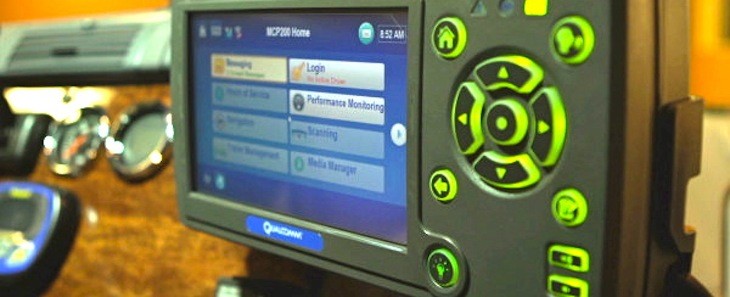Technology provider offers insights on ELD setup; ABF, FedEx Freight ready for Dec. 18 mandate
by October 23, 2017 4:48 pm 1,662 views

The federal mandate requiring big rig drivers to track their duty status and hours of service using electronic logging devices (ELDs) is set to go into effect in 55 days, but drivers of two large carriers in Arkansas have prepared for it well in advance.
“Since Feb. 1, 2017, all ABF Freight drivers have used electronic logging devices as the official record of duty, well ahead of the mandate,” said Kathy Fieweger, spokeswoman for Fort Smith-based ArcBest, ABF’s parent company. “The ELDs provide improved tracking of customer freight and allow us to continue our exceptional safety record.”
FedEx Freight has “substantially completed” installing ELDs in its fleet, according to a company statement. “We support the use of ELDs and the safety benefits they provide to motor carriers, drivers and the general motoring public.”
On Oct. 12, Susan Reszczynski, sales engineer and product advocate, and Soona Lee, regulatory compliance manager, both of Eroad, discussed the three steps to set up an ELD and shared some insights from their experience with setting up the devices for carriers in a webinar hosted by Transport Topics, a publication of American Trucking Associations. Eroad is one of more than 100 ELD providers registered on the Federal Motor Carrier Safety Administration website.
The steps include install the ELD, setup back-end system and train entire team. First, companies should compile a list of their vehicles to determine which vehicles will require an ELD. Drivers of trucks older than model year 2000 or drivers who track hours-of-service logs less than eight days in a month won’t need to use an ELD. Also, all rental trucks in use for eight days or less will be exempt from having to use ELDs, according to Transport Topics.
“Make sure you have compiled a proper list of vehicles,” Reszczynski said. Some of their customers have had outdated vehicle lists.
Some vehicles will require different cables and connections between the engine and ELD, Lee said. Some ELDs can be self-installed or installed by the ELD provider or a third-party installer. Installation costs between $50 and $75 and takes between 30 and 45 minutes, Reszczynski said. A third-party installation might cost up to $150.
“Everybody is installing these things,” she said. “Time is getting shorter and shorter.”
Starting Dec. 18, drivers who track hours of service with paper logs will be required to use an ELD to track them. However, trucks that don’t comply with the ELD mandate will not be placed out of service for the violation until April 1, according to the Commercial Vehicle Safety Alliance. Also, fleets using automatic onboard recording devices (AOBRD) have until Dec. 16, 2019, to become compliant with the ELD mandate.
However, if the AOBRD must be replaced before the extended deadline, it must be replaced with an ELD. Fleets replacing trucks can use the AOBRD in a replacement truck through the extended deadline.
On Oct. 20, the Federal Motor Carrier Safety Administration granted UPS several “five-year exemptions” from parts of the ELD mandate, including the use of AOBRDs as it converts its fleet to ELDs, according to Transport Topics. Other exemptions include how data is collected “for drivers who log out of an ELD while outside a vehicle, drivers who make yard moves and nondriver employees who operate vehicles.”
Reszczynski and Lee stressed the importance of training the entire staff on ELDs, not just the drivers. Initial training on the device can be conducted in a safety meeting in about an hour, Reszczynski said. Then, drivers can receive further individual training in possibly five to 10 minutes sessions. Some of the training that needs to take place includes how to log in and out of the device with one’s personal pin and how to change duty status.
“Anytime that vehicles hits 5 mph that driver time has to be assigned to someone.”
Carriers should have someone managing the unidentified driver trips.
Under the ELD mandate, drivers can edit their logs. Some ABORDs didn’t allow drivers to do this, Reszczynski said. Reszczynski and Lee also discussed what to ask ELD providers, including timeframes and methods of delivery of the devices, contingency plans, installation and troubleshooting. Reszczynski said to keep in touch with the installer and determine the best way in which to communicate with the provider.
“When a driver calls in a panic, you need to know who to call. You will need help.”
If an ELD stops working, carriers have eight days to resolve the issue, and drivers must keep paper logs during that time. Lee suggested a phased in approach to installing the devices.
“As long as it’s digestible, it’s workable for the drivers,” she said. “Set up one group of users at a time.”
Along with tracking hours of service and duty status of a driver, ELDs can be used to provide extra visibility and insights over a fleet, Reszczynski said. Also, some can also track vehicle maintenance logs and tax compliance information. Its features could be used to show insurance companies that carriers are the “better bet,” leading insurance rates to go down.
